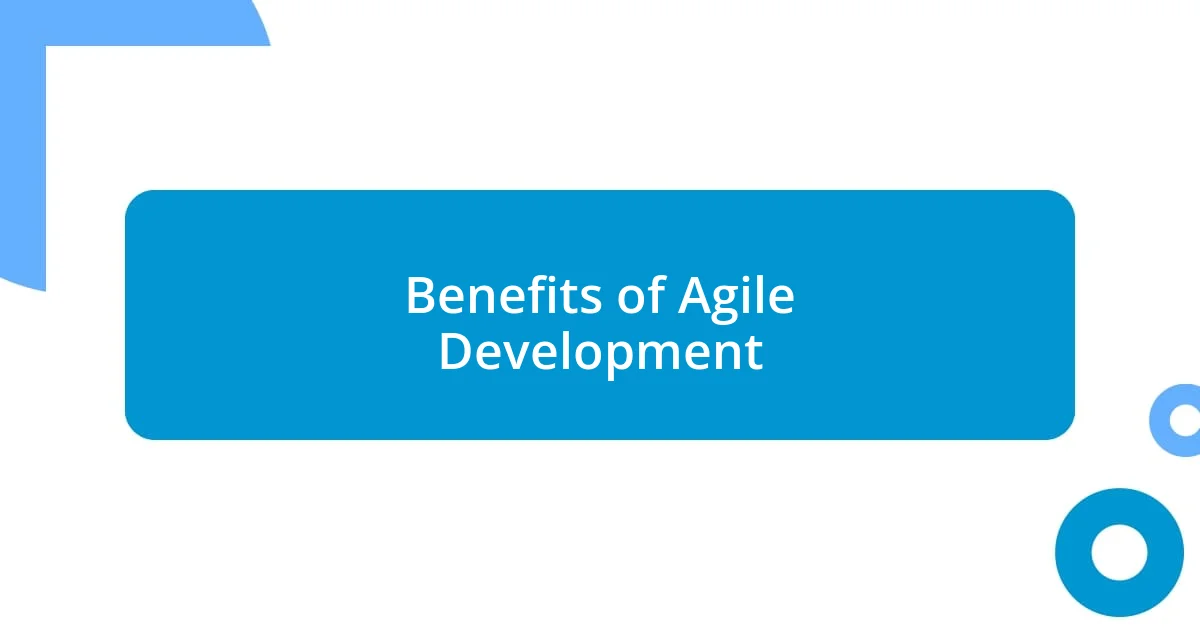Key takeaways:
- Agile’s iterative approach enables teams to quickly adapt to changes, fostering flexibility and responsiveness while maintaining momentum.
- Key principles of Agile emphasize collaboration, customer feedback, and valuing team dynamics over rigid processes, enhancing overall project outcomes.
- Common frameworks like Scrum, Kanban, and Lean encourage productivity, visual progress tracking, and efficiency through continuous improvement and elimination of waste.

Understanding Agile Development Methods
Agile development methods pivot around the core idea of flexibility. I recall a project where a sudden change in client requirements led to a complete overhaul of our initial plan. Instead of feeling stressed, the team adapted swiftly, demonstrating how Agile’s iterative approach allows for quick adjustments without losing momentum.
I’ve always enjoyed the emphasis on collaboration in Agile practices. For me, daily stand-up meetings were a breath of fresh air. They fostered open communication, allowing team members to share updates and raise concerns in real-time. Isn’t it comforting to know that everyone’s voice matters in the process?
One key aspect of Agile that I cherish is the focus on delivering value incrementally. Early in my career, working on a product that underwent continuous feedback cycles taught me that releasing smaller, functional pieces can provide immediate benefits. Have you ever experienced a situation where immediate feedback reshapes your understanding of a project? That’s the Agile way—learning and evolving continuously.

Key Principles of Agile Approach
One of the most refreshing principles of the Agile approach is its strong focus on customer collaboration. I remember a time when a client’s feedback led us to pivot towards a solution we hadn’t initially envisioned. Their insights not only enhanced the product but also strengthened our relationship. This level of engagement is at the heart of Agile, ensuring that the end user is always prioritized.
Here are some key principles that guide the Agile methodology:
- Individuals and Interactions over Processes and Tools: Emphasizes the importance of team dynamics and communication.
- Working Software over Comprehensive Documentation: Encourages delivering functional software frequently, reducing excessive paperwork.
- Customer Collaboration over Contract Negotiation: Prioritizes feedback and input from clients throughout the process.
- Responding to Change over Following a Plan: Accepts changes as part of the process, adapting to new information and requirements as they arise.
In my experience, embracing these principles can lead to more satisfying outcomes and a valued team culture.

Benefits of Agile Development
When I think about the benefits of Agile development, one crucial advantage stands out: enhanced adaptability. I recall a project where unexpected market shifts demanded quick decisions. Thanks to Agile practices, our team was able to reroute our efforts without feeling overwhelmed. This flexibility is something I truly admire, as it allows teams to respond effectively to change rather than be bogged down by rigid plans.
Moreover, the iterative nature of Agile development often brings forth increased productivity. Reflecting back, I’ve seen firsthand how breaking projects into smaller tasks not only makes them feel more manageable but also keeps the team motivated. Each completed sprint felt like a small victory, which drove us further and maintained a high team spirit. Have you ever felt that surge of accomplishment after achieving a milestone? It’s remarkable how Agile nurtures that feeling consistently.
Finally, Agile’s focus on continuous improvement creates a culture of learning. In one of my past roles, we implemented regular retrospectives, allowing us to assess our performance openly. This process was eye-opening; it not only led to better practices but also fostered stronger camaraderie within the team. Isn’t it inspiring to work in an environment that encourages growth and collaboration?
| Benefit | Description |
|---|---|
| Adaptability | Agile allows teams to pivot quickly in response to changing requirements and market conditions. |
| Increased Productivity | Breaking down projects into smaller tasks boosts motivation and helps maintain team spirit through completed milestones. |
| Continuous Improvement | Regular retrospectives foster a culture of learning and collaboration, enhancing overall team dynamics. |

Common Agile Frameworks Explained
When discussing common Agile frameworks, Scrum is often the first that comes to mind. In my experience, Scrum truly embodies the essence of Agile with its time-boxed iterations called sprints. I recall a project where we used Scrum; the daily stand-ups kept everyone aligned and energized. It was fascinating to see how such brief meetings fueled our progress—has anyone else felt that sense of unity from quick check-ins?
Another pivotal framework is Kanban, which focuses on visualizing work to enhance flow. I’ve implemented Kanban boards in several projects, and they’ve been revolutionary. Watching tasks move from ‘To Do’ to ‘Done’ can be exhilarating; it feels like watching the tangible progress of our efforts. Have you ever found motivation in simply seeing your tasks visually represented?
Lastly, there’s Lean, which emphasizes eliminating waste to improve overall efficiency. Adopting Lean principles in a previous project made me more conscious of our processes. It always amazed me how small adjustments, like reducing unnecessary meetings, dramatically streamlined our workflow. Isn’t it incredible how a shift in mindset can lead to such impactful changes?

Challenges of Agile Implementation
Implementing Agile can be quite a journey, often filled with unexpected bumps along the way. I remember a particular project where, despite our excitement to adopt Agile, the team struggled with a lack of buy-in from some members. Have you ever faced resistance from colleagues during a shift in strategy? It’s challenging when not everyone is on board, as it can create friction and dilute the overall effectiveness of Agile practices.
Another challenge I frequently encountered was the chaos that can come from the high degree of responsiveness Agile encourages. In one instance, we found ourselves constantly pivoting based on feedback, which sometimes led to decision fatigue. It made me ponder—how do we balance flexibility with maintaining a clear direction? Finding that sweet spot can be tricky but is critical in ensuring that Agile doesn’t become a source of confusion instead of clarity.
Moreover, the iterative nature of Agile means that constant feedback is essential, but it can also overwhelm teams. I’ve seen colleagues who thrived on structured plans feel anxious during rapid iterations and frequent updates. Have you ever felt pressured to keep up with unending feedback loops? This tension between rapid iteration and team bandwidth is something that needs careful management if we want to maintain morale and keep productivity high.

Best Practices for Agile Success
In my experience, fostering a culture of open communication is a cornerstone of Agile success. I once worked on a team where we designated ‘feedback hours’ each week, allowing everyone to express concerns and ideas without the fear of judgment. It was refreshing to see how such candid discussions led to real improvements; have you ever found that a simple conversation changed the course of a project for the better?
Another best practice that I can wholeheartedly endorse is the importance of continuous learning and adaptation. There was a memorable time when our team held regular retrospectives after each sprint, and this practice allowed us to dissect what went right and what didn’t. It was during one of these sessions that we discovered how small tweaks in our workflow could lead to significant gains. Reflecting on past experiences—how often do you take the time to learn from successes and setbacks?
Finally, embracing the concept of small, cross-functional teams has proven invaluable in my Agile journeys. I recall the exhilarating energy of a project where our team of five, consisting of developers, a tester, and a product owner, collaborated closely from day one. The synergy we created not only fostered creativity but also sped up the delivery of features. Have you ever experienced the magic that comes from tight-knit teams sharing diverse skills and perspectives? The results can be nothing short of transformative.

My Personal Experience with Agile
During my journey with Agile, I vividly remember a project where we hit the ground running, full of enthusiasm. Yet, as we worked through our sprints, I noticed a growing frustration among team members who were adapting to a new workflow. I often wondered if anyone else felt that pressure of switching gears and how it could dampen our initial excitement. There’s something disheartening about seeing passion turn into burnout when the pace feels relentless.
One moment that stands out for me was during a sprint review where we were all ready to present our progress. However, as I took note of the feedback rolling in, I could see some team members visibly tense up. It struck me that, while feedback is crucial, the way we approached it needed to evolve. Have you ever witnessed the impact of a poorly timed critique? It was a clear reminder that constructive feedback should come wrapped in encouragement to help maintain our momentum.
Reflecting on my experience in Agile, I’ve come to appreciate the importance of celebrating small wins. There were instances where, after completing a sprint successfully, we would take a moment to acknowledge our collective effort. I found that this practice not only motivated the team but also reinforced a sense of camaraderie. Don’t you agree that acknowledging achievements, no matter how small, can uplift the spirit of a team? That little boost really made a difference in our overall productivity and morale.














